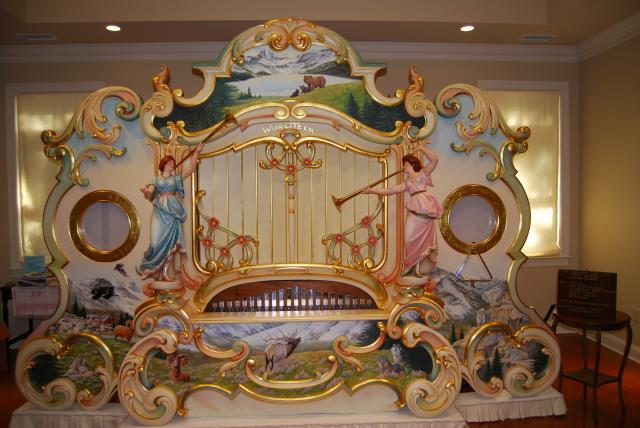Wurlitzer 165 Band Organ

WURLITZER 165 / 166 BAND ORGAN
In 1914, the Rudolph Wurlitzer Co. introduced the 165 band organ, which has become the most musical and best loved American band organ. The 165 was for years the largest production model that Wurlitzer made. The 165 was intended musically to duplicate a large military band and was designed for large carousels, roller coasters, parks, and large indoor park dance pavilions.
The 165 band organ was driven by an electric motor that powered a crankshaft serving a separate pressure pump for pipe wind pressure, a vacuum pump for the pneumatics that drove all the “keys” and in turn the playing notes and controls, and a friction drive wheel that powered the duplex roll mechanism.
The Tracker scale has 75 holes, with 52 actual playing notes for Bass (6 notes, 3 sets of pipes), Accompaniment (10 notes, 2 sets of pipes), Melody (22 notes, 8 sets of pipes + bells), and counter-melody (14 notes, 3 sets of pipes), the rest for controls and drums. The scale is not chromatic and there are various missing notes (typically flats and sharps) for expediency.
24 original Wurlitzer 165’s were produced of which 10 survive. Additionally, Wurlitzer factory converted some other organs to 165’s, of which only a few survive. This organ is such an example.
The 165 organ was based on a German Bruder design. This organ was an original Bruder organ, factory converted to a duplex Wurlitzer 165 and according to the original Wurlitzer factory ledger sheet, left the Wurlitzer factory, August 11, 1915, only one year after the original year of 165 production. It was shipped to carousel operator C. W. Parker, Laporte, Indiana, and contracted to carnival showman Harry W. Wright who apparently used it for many years in a carnival. Intervening year history is unknown until it was discovered derelict, without its façade, and missing some pipes and parts in a barn in Wisconsin in 2006 where it apparently had been stored many years.
Band organ specialist Joe Hilferty of York, PA did the mechanical restoration. Some parts and pipes had to be made. Since this organ had original brass trumpet pipes not typical of a 165, but only on the larger 166, some other pipe ranks typical of the style 166 were added to give the organ a slightly expanded sound and also take advantage of the other registers perforated into the 165 rolls unique only to a 166. Other features unique to the expanded style 166 scale were added such as uniphone bells and snare drum fortissimo.
A non-invasive computerized midi system was added to allow newly arranged music to be played that would likely never make it to paper rolls for economic reasons.
A replica façade was carved by Bob Yorburg, Yorktown Heights, NY. It was illustrated by Marguerite Chadwick-Juner, NY and finished (leafing, painting) by Pamela Hessey, Hawk’s Eye Studio, Kingman, AZ.
The organ contains 316 pipes, with * indicating the ranks added for the larger style 166:
MELODY: 44 soft violin, 44 loud violin, 22 prestant violin*, 22 stopped flutes, 22 small piccolo, 22 large piccolo*, 22 flageolets (total: 198 pipes)
COUNTER MELODY: 14 brass trumpets*, 14 wood trumpets, 14 stopped flutes, 14 bassoons, 14 2ft. wood violas (total: 70 pipes)
ACCOMPANIMENT: 10 stopped flutes, 10 2 ft. open flutes, 10 4 ft. open flutes* (total: 30 pipes)
BASS: 6 8 ft. bass, 6 4 ft. stopped bass, 6 trombones (total: 18 pipes)
OTHER: 22 bells, 22 uniphone bells, bass drum, snare drum, snare drum fortissimo, tympani, cymbal, triangle, castanets, wood block
This organ rear view shows closeup of duplex music roll mechanism, large flat belt drive mechanism and part of vacuum pump above roll mechanism.

